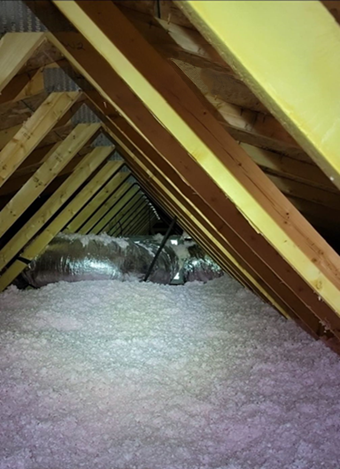Application of the building science principles of heat transfer indicates that Heating, ventilation, and air conditioning (HVAC) systems located in unconditioned attics are inefficient, typically increasing energy usage by 25 to 50%. Conventional wisdom is that tightly sealed ducts, well insulated and buried in the attic insulation, can reduce this energy waste; however, often ignored is the critical need to ensure easy access to appliances located in attics, such as furnaces, evaporator coils, and filters. Mechanical and energy codes address this, but unfortunately, these minimal requirements are for access opening size, attic catwalks, and service platforms are often ignored.
Recently, Dr. Energy received a call from some good friends who had several questions about their HVAC system in their newly constructed getaway home in Southern Utah. While discussing their questions and concerns, Dr. Energy asked if they could provide a few photos of the HVAC system in the attic, specifically the furnace, coil, and duct, expecting they could easily access the service platform in front of the furnace. Unfortunately, this was not the case. This is one of the photos received:

Furnance aPPARATUS
Yes, that’s the furnace and cooling coil, 24’ from the access opening. The design of this HVAC system does not meet any of the following code requirements outlined in the 2000 IRC, Section M1305.1.3:
- access opening size, a distance not more than 20’ from the appliance to access
- a continuous 24” wide floor/catwalk above the insulation
- a level service platform, a minimum 30” deep in front of all sides, requiring access
- a light at the appliance controlled at the access
- a service receptacle near the appliance
In the 2006 IRC, an exception was added, allowing a 22” wide catwalk, up to 50’ long if there is 6’ high clearance from the access to the appliance. This section remains unchanged in the 2009, 2012, 2015, 2018, and 2021 IRC. If the height is less than 6’, the distance from access to the appliance is limited to 20’.
Why is Dr. Energy addressing this in an energy code blog? For the contractors out there, it’s in the mechanical and energy codes. A condition of your DOPL-issued state license is construction that is in compliance with the adopted codes. While Dr. Energy doesn’t expect HVAC contractors to build the platforms and catwalks, working with builders to educate them on this requirement is important. Don’t be shy in asking inspectors, “Doesn’t the code require a light, receptacle, platform, and catwalk?” Inspectors are also licensed by Division of Professional Licensing (DOPL), with a similar requirement to enforce the adopted codes. This is an important issue impacting both efficiency and comfort that desperately needs attention. Please consider:

- Where access is poor, maintenance is rarely performed. Mechanical system failures are common result of poor maintenance and often require greater time and expense to repair. Additionally, poorly maintained HVAC systems are inefficient and experience drastically shortened system life.
- The photo above was taken in a home in Climate Zone 3, Washington County, an area where virtually all attic furnaces are installed. Logically, this area should be the most proactive in compliance with this section.
- Moving through insulation disturbs and compresses it, reducing the effective R-value of the attic insulation. Referencing the photo above, it would be hard to return the insulation to its fluffed-up effective condition after multiple trips to and from the appliance for servicing. Also, notice the return plenum does not appear to be insulated.
- Ducts in attics are often damaged, crushed, and pulled apart by individuals traversing attics.
- Catwalks and platforms minimize disturbing loose blown insulation and reduces the respiratory hazards of breathing the particles suspended in the air.
